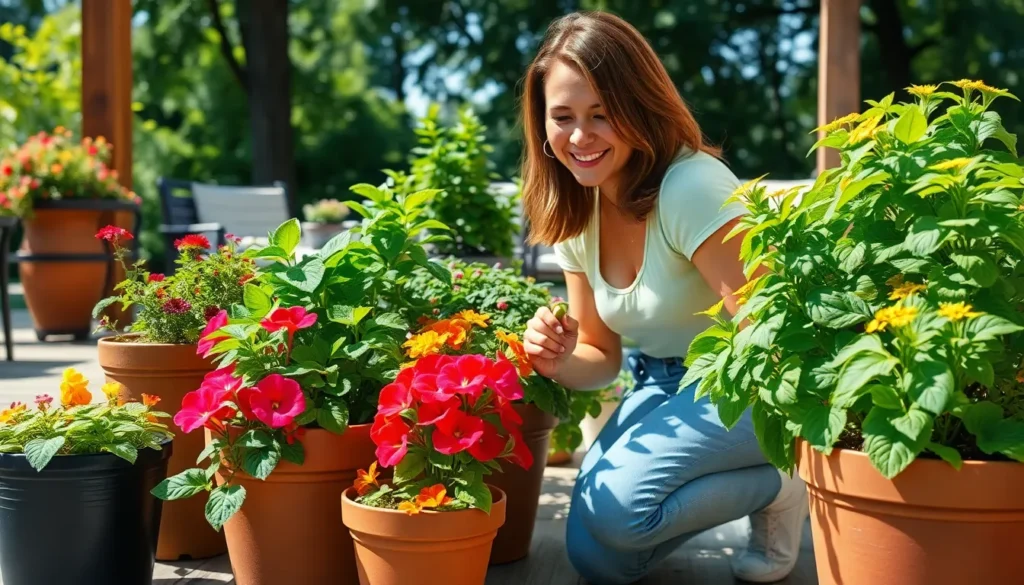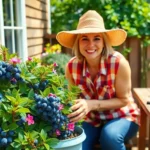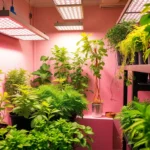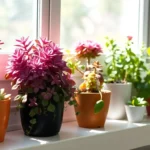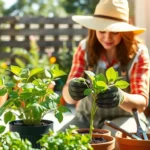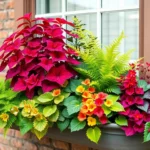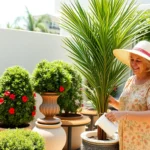Container gardening opens up endless possibilities for transforming any space into a thriving green oasis. Whether you’re working with a balcony, patio, or small yard, part sun container plants offer the perfect solution for those tricky spots that receive 3-6 hours of sunlight daily.
We’ve discovered that these versatile plants are game-changers for gardeners dealing with partially shaded areas. Unlike their full-sun counterparts, part sun varieties thrive in moderate light conditions while still producing stunning blooms, lush foliage, and even fresh herbs and vegetables. They’re incredibly forgiving and adapt beautifully to container life.
The beauty of part sun container gardening lies in its flexibility and accessibility. We can create stunning displays that work perfectly for beginners and seasoned gardeners alike. From colorful annuals to productive edibles, these plants prove that you don’t need blazing sunshine all day to cultivate a gorgeous container garden that’ll be the envy of your neighborhood.
Best Flowering Part Sun Container Plants for Colorful Displays
Building on the versatility of part sun gardening, we’ll explore stunning flowering plants that transform containers into vibrant displays throughout the growing season.
Begonias for Continuous Summer Blooms
Begonias deliver exceptional performance in part sun containers, producing flowers from spring until the first frost. We recommend wax begonias and tuberous begonias as top choices for their reliable blooming habits and heat tolerance.
Wax begonias thrive in containers with 4-5 hours of morning sunlight, offering compact growth reaching 6-12 inches tall. These workhorses produce white, pink, red, or salmon flowers continuously without deadheading requirements.
Tuberous begonias create dramatic displays with their large, ruffled blooms measuring 3-6 inches across. Plant these showstoppers in well-draining potting mix and provide consistent moisture for optimal flowering performance.
Care requirements include weekly fertilizing with balanced liquid fertilizer and protection from intense afternoon sun. Position containers where they’ll receive gentle morning light and afternoon shade for best results.
Impatiens for Shade-Tolerant Color
Impatiens excel in part sun containers, especially in areas with filtered light or morning sun exposure. We’ve found these reliable bloomers perfect for brightening darker corners of patios and porches.
Standard impatiens produce abundant flowers in white, pink, red, orange, purple, and bicolor combinations. These plants grow 8-12 inches tall and spread 12-18 inches wide, making them ideal for larger containers.
New Guinea impatiens offer larger flowers and variegated foliage, tolerating slightly more sun than standard varieties. Plant spacing should allow 10-12 inches between plants for proper air circulation and growth.
Watering needs require consistent moisture without waterlogged conditions. Check soil daily during hot weather, as impatiens wilt quickly when stressed from drought.
Coleus for Vibrant Foliage and Flowers
Coleus provides stunning foliage color that outshines many flowering plants, thriving in part sun containers with 3-4 hours of direct sunlight. We love how these plants maintain their colorful displays even when flowers fade on other plants.
Foliage varieties showcase leaves in combinations of green, red, purple, yellow, and pink patterns. Popular cultivars like ‘Wizard Mix’ and ‘Kong Series’ offer compact growth perfect for container cultivation.
Flower management involves pinching flower spikes to maintain bushy growth and intense leaf coloration. Remove spikes regularly to direct energy into foliage development rather than seed production.
Size options range from dwarf varieties reaching 8-10 inches to larger specimens growing 18-24 inches tall. Choose compact varieties for smaller containers and trailing types for hanging baskets or elevated planters.
Top Herb Part Sun Container Plants for Culinary Gardens
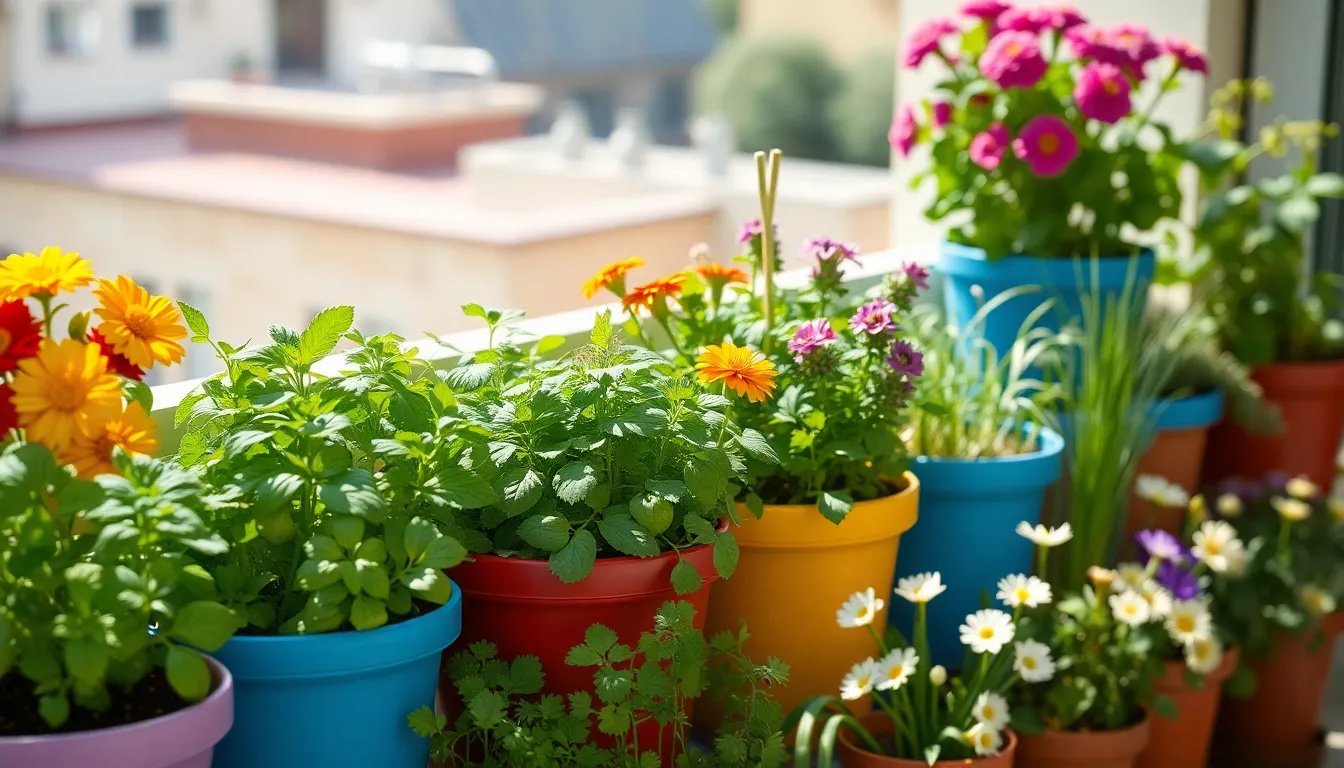
Culinary herbs bring exceptional functionality to part sun container gardens, offering fresh flavors while thriving in 3 to 6 hours of daily sunlight. These versatile herbs transform ordinary containers into productive kitchen gardens that complement our flowering displays.
Basil Varieties That Thrive in Partial Sunlight
Basil adapts remarkably well to part sun conditions when we provide proper care and attention. While it typically prefers 6 to 8 hours of full sun, basil can flourish with partial sunlight if we ensure well drained soil and frequent harvesting to encourage continuous leaf growth.
Popular container varieties include Genovese, Nufar, Dolce Fresca, and Spicy Globe, each offering distinct flavors for our culinary needs. Pinching off flower buds becomes crucial for maintaining optimal leaf flavor, as flowering significantly reduces the taste quality we desire. Regular harvesting promotes fresh leaf production and keeps our basil plants productive throughout the growing season.
Container placement on sunny balconies or decks works exceptionally well, particularly when morning sunlight reaches our basil plants. We can successfully grow these aromatic herbs in pots and window boxes, making them accessible for daily kitchen use.
Parsley for Year-Round Fresh Herbs
Parsley stands out as one of the most reliable herbs for part sun container gardens, thriving even in shadier conditions than most culinary plants. This versatile herb actually prefers moist, well drained soil and demonstrates remarkable tolerance for limited sunlight exposure.
Growing characteristics make parsley ideal for containers that don’t receive consistent full sun throughout the day. We can position parsley in areas where other herbs might struggle, making it perfect for north facing balconies or partially shaded patios. Its ability to grow in less intense light conditions provides us with consistent harvests regardless of our garden’s sun exposure.
Fresh parsley remains available for harvesting throughout most of the year in suitable climates, offering us a dependable source of fresh herbs for cooking and garnishing.
Chives for Easy-Care Perennial Harvests
Chives provide the ultimate low maintenance solution for our part sun container herb gardens, offering perennial growth that returns year after year. These hardy herbs require minimal care once established and tolerate part sun environments exceptionally well.
Harvesting benefits include frequent cutting opportunities that actually promote healthier plant growth and continued production. We can cut chives regularly without damaging the plant, as this encourages new growth and maintains plant vigor throughout the growing season.
Container growing suits chives perfectly since they don’t require extensive root space and adapt well to pot restrictions. Their tolerance for partial sunlight means we can place them in areas where full sun herbs might struggle, making them ideal companions for our other part sun container plants.
Ideal Vegetable Part Sun Container Plants for Small Space Gardening
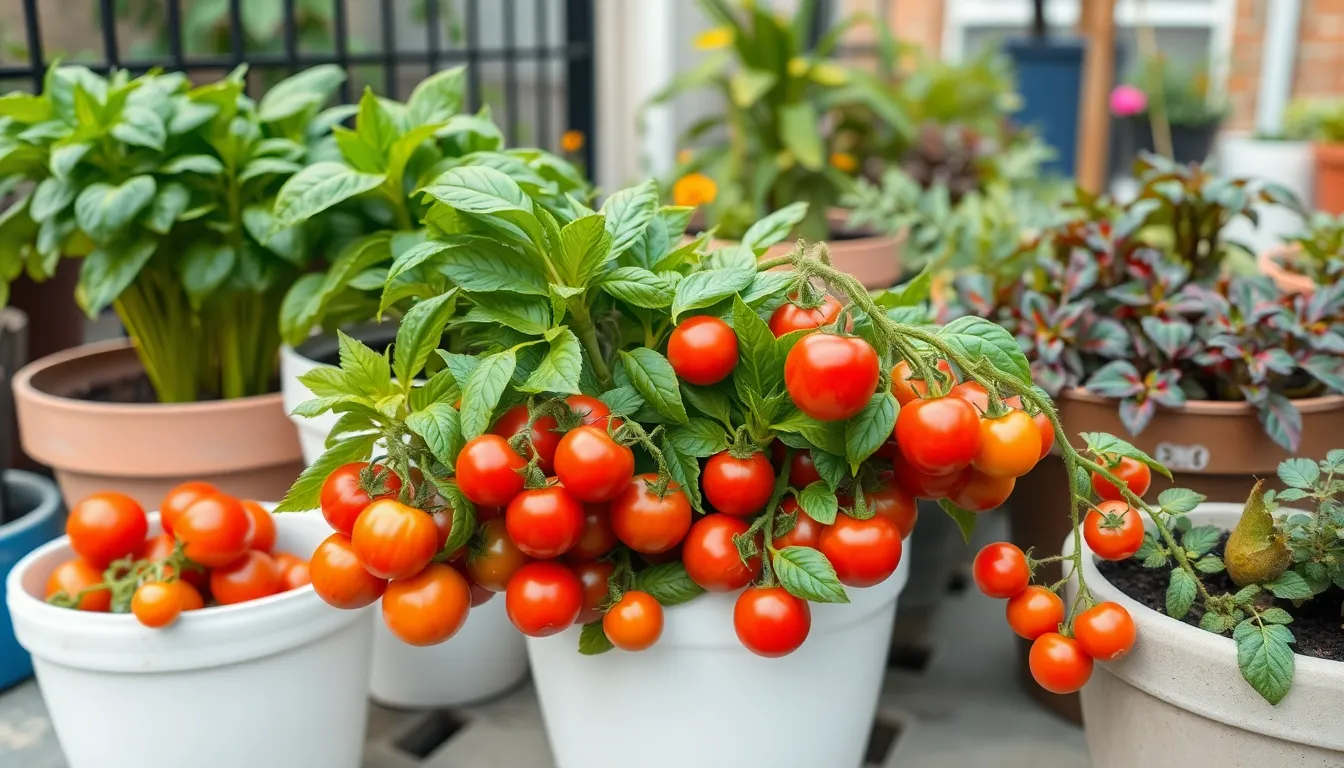
We can create productive vegetable gardens even in spaces with limited sunlight. These carefully selected vegetables thrive in part sun conditions while providing fresh produce for your kitchen.
Leafy Greens That Flourish in Partial Sun
Lettuce serves as the champion of part sun container gardening. We recommend growing lettuce as a “cut-and-come-again” crop for continuous harvests. During hot summers, lettuce actually benefits from part shade to prevent bolting or going to seed prematurely. Frequent watering keeps the soil moist but well-drained for optimal growth.
Spinach adapts beautifully to partial sunlight conditions. Cool-season nature makes this green tolerant of shade while still producing nutritious leaves. Growth may be slower in reduced light, but the quality remains excellent for fresh salads and cooking.
Swiss Chard demonstrates remarkable adaptability in 3-4 hours of sunlight. Heat and shade tolerance make it ideal for container growing throughout the season. Bright Lights variety adds vibrant color to both your garden and dinner plate with its rainbow-colored stems.
Arugula thrives in partial sun while delivering intense, peppery flavor. Quick-growing nature means you’ll harvest fresh leaves within weeks of planting. Multiple sowings throughout the season ensure continuous production.
Kale tolerates shade and cooler temperatures exceptionally well. Container growing allows us to position this superfood green in various locations throughout the growing season. Regular harvesting encourages new growth and maintains tender leaves.
Cherry Tomatoes for Container Success
Cherry tomatoes can adapt to part sun conditions with 4-6 hours of direct sunlight daily. Smaller varieties tend to be more forgiving than full-size tomatoes in reduced light conditions. While yields may be lower compared to full sun growing, we still achieve satisfying harvests.
Container growing provides better control over soil drainage and nutrients. Well-draining potting mix prevents root rot in partially shaded areas where soil stays moist longer. Regular feeding with balanced fertilizer compensates for reduced photosynthesis in lower light.
Compact determinate varieties work best for part sun container growing. These plants stay smaller and focus energy on fruit production rather than excessive vine growth. Choosing disease-resistant varieties increases success rates in potentially humid, partially shaded locations.
Peppers That Adapt to Less Light
Peppers require at least 4-6 hours of daily sunlight to produce fruit successfully. Smaller ornamental pepper varieties adapt better to partial sun conditions than large bell pepper types. While fruit production may be reduced, proper care still yields flavorful harvests.
Container growing allows us to optimize growing conditions for part sun peppers. Well-draining soil prevents waterlogged roots in areas with less sun exposure. Consistent watering schedules help compensate for reduced light energy by maintaining steady growth.
Compact pepper varieties like small hot peppers or mini sweet peppers perform better in partial sun. These plants naturally require less energy to produce fruit compared to large varieties. Regular feeding with potassium-rich fertilizer supports fruit development in lower light conditions.
Best Perennial Part Sun Container Plants for Long-Term Growth
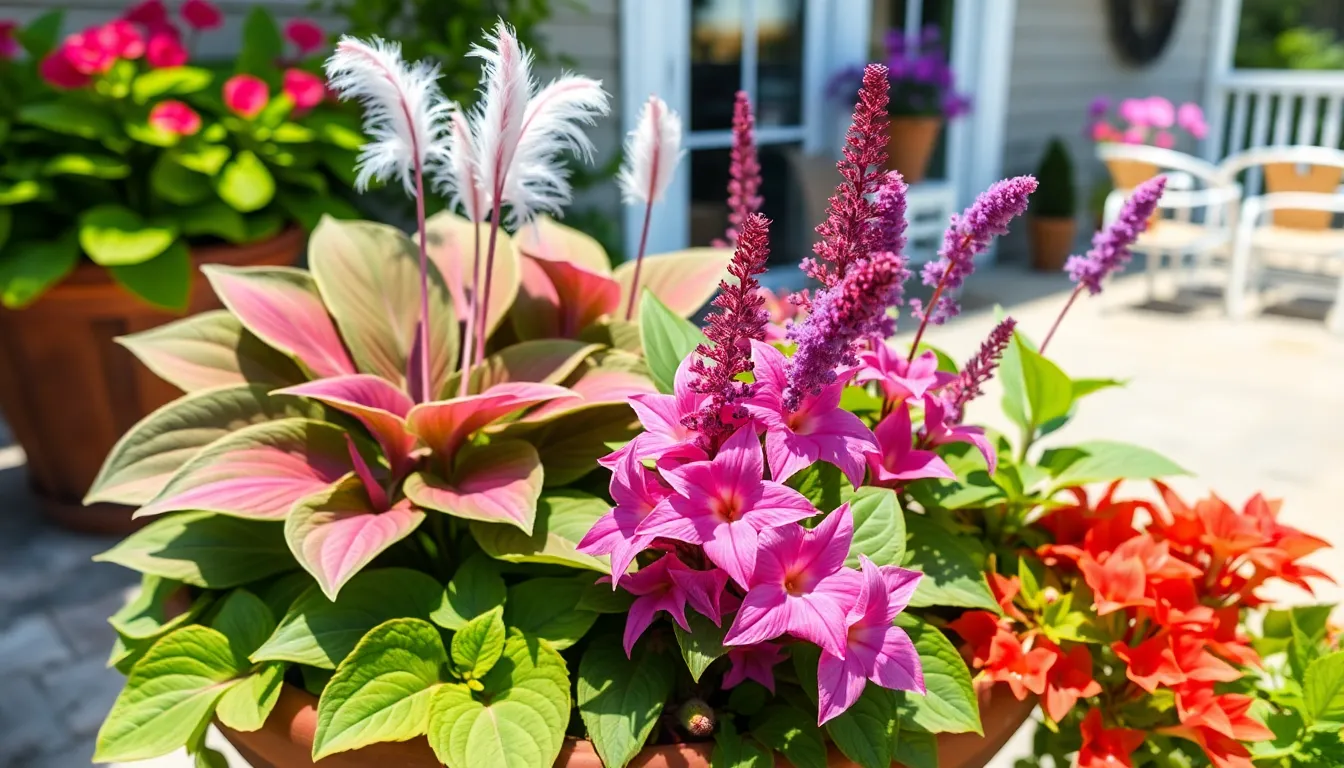
When we want lasting beauty in our container gardens, perennials offer the best value and seasonal interest. Unlike annuals that need replanting each year, these hardy plants return season after season, making them perfect investments for part sun spaces.
Hostas for Reliable Foliage Appeal
Hostas earn their reputation as the “queen of the shade border” through their exceptional performance in part sun containers. These mounding plants range from compact 6-inch varieties to impressive 48-inch specimens, with spreads reaching up to 72 inches in larger containers. Their lush foliage comes in countless colors, patterns, and textures, creating stunning visual impact without relying on flowers.
We love hostas for their versatility in container combinations. They pair beautifully with ferns and astilbe, creating rich textural contrasts that evolve throughout the growing season. The low maintenance requirements make them ideal for busy gardeners, while their adaptability to various light conditions ensures success in part sun locations.
Astilbe for Feathery Flower Plumes
Astilbe brings vertical drama to our container gardens with its delicate, feathery flower plumes that dance in the breeze. These perennials thrive in partial sun to full shade conditions, making them perfect companions for moisture-loving container plants. Their blooms emerge in stunning colors ranging from pure white to deep burgundy red.
The texture contrast astilbe provides complements broader-leafed plants like hostas and coral bells perfectly. We appreciate how their plumes add softness and movement to container compositions, creating visual interest that extends well beyond the blooming period. Their preference for consistent moisture makes them excellent choices for self-watering containers or areas where we can maintain regular watering schedules.
Coral Bells for Colorful Leaves and Blooms
Coral bells offer the best of both worlds with their vibrant foliage and delicate flower spikes. These versatile perennials grow 6 to 18 inches tall with spreads of 12 to 30 inches, making them perfect for container layering. Their leaves showcase incredible diversity, from bright lime green to deep purple and burgundy, with many varieties featuring striking patterns and color combinations.
We find coral bells incredibly adaptable to various growing conditions, tolerating both sun and shade while maintaining their colorful appeal. Their mounding habit makes them excellent fillers in mixed containers, where they provide year-round interest through their foliage. The delicate flower spikes that emerge in spring and summer add an extra layer of beauty without overwhelming the overall composition.
Essential Succulent Part Sun Container Plants for Low Maintenance
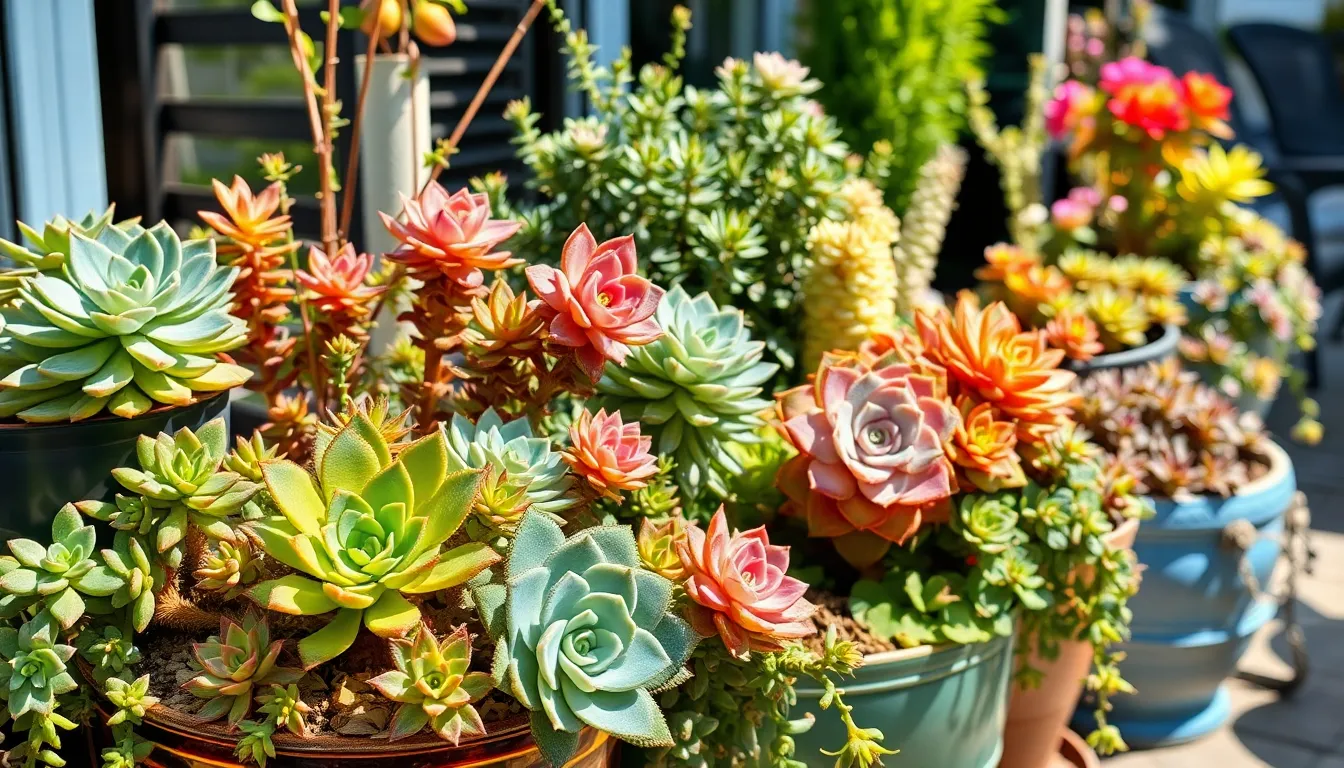
Succulents offer the perfect solution for gardeners seeking beautiful plants with minimal care requirements. These drought tolerant plants thrive in part sun conditions while providing stunning visual appeal with very little maintenance.
Jade Plants for Indoor-Outdoor Flexibility
Jade plants stand out as versatile succulents that flourish in both indoor and outdoor settings with partial sunlight exposure. Their thick, fleshy leaves store water efficiently, making them incredibly resilient and perfect for busy gardeners who can’t maintain regular watering schedules. We recommend jade plants for their adaptability to various lighting conditions, requiring only well-draining container soil to prevent root rot.
These popular succulents develop into attractive, tree-like specimens over time, adding structural interest to any container arrangement. Watering requirements remain minimal throughout the year, with jade plants actually preferring to dry out completely between waterings. Container gardeners appreciate their low maintenance nature and ability to transition seamlessly between indoor winter protection and outdoor summer growth.
Echeveria Varieties for Rosette Beauty
Echeveria species create stunning focal points with their symmetrical, colorful rosette formations that catch the eye in any container garden. These succulents prefer bright, indirect sunlight and tolerate partial sun conditions exceptionally well, making them ideal for patios and balconies with filtered light. We’ve found that echeveria varieties require minimal watering and thrive in well-drained soil, producing their most vibrant colors when slightly stressed by dry conditions.
Popular varieties include Echeveria elegans with its blue-green leaves and Echeveria ‘Black Prince’ featuring deep purple foliage that darkens in brighter light. Their compact growth habit makes them perfect for small containers or as centerpieces in larger arrangements. Regular removal of dead lower leaves keeps these rosettes looking their best while encouraging healthy new growth from the center.
Sedum Species for Ground Cover Appeal
Sedum varieties, commonly known as stonecrops, excel as hardy container plants that tolerate partial sun and poor soil conditions with remarkable resilience. Their creeping growth habit makes them excellent choices for container edges, where they can spill gracefully over the sides while adding texture and seasonal color. We particularly value sedums for their ability to thrive with infrequent watering and minimal soil amendments.
Ground cover sedums like Sedum spurium and Sedum kamtschaticum spread quickly to fill containers while producing small, star-shaped flowers in summer months. These low-growing varieties create living mulch that helps retain soil moisture and suppress weeds in larger containers. Their succulent leaves change colors throughout the seasons, providing year-round interest even when not in bloom, making them valuable additions to any low maintenance container garden.
Optimal Soil and Drainage Requirements for Part Sun Container Plants
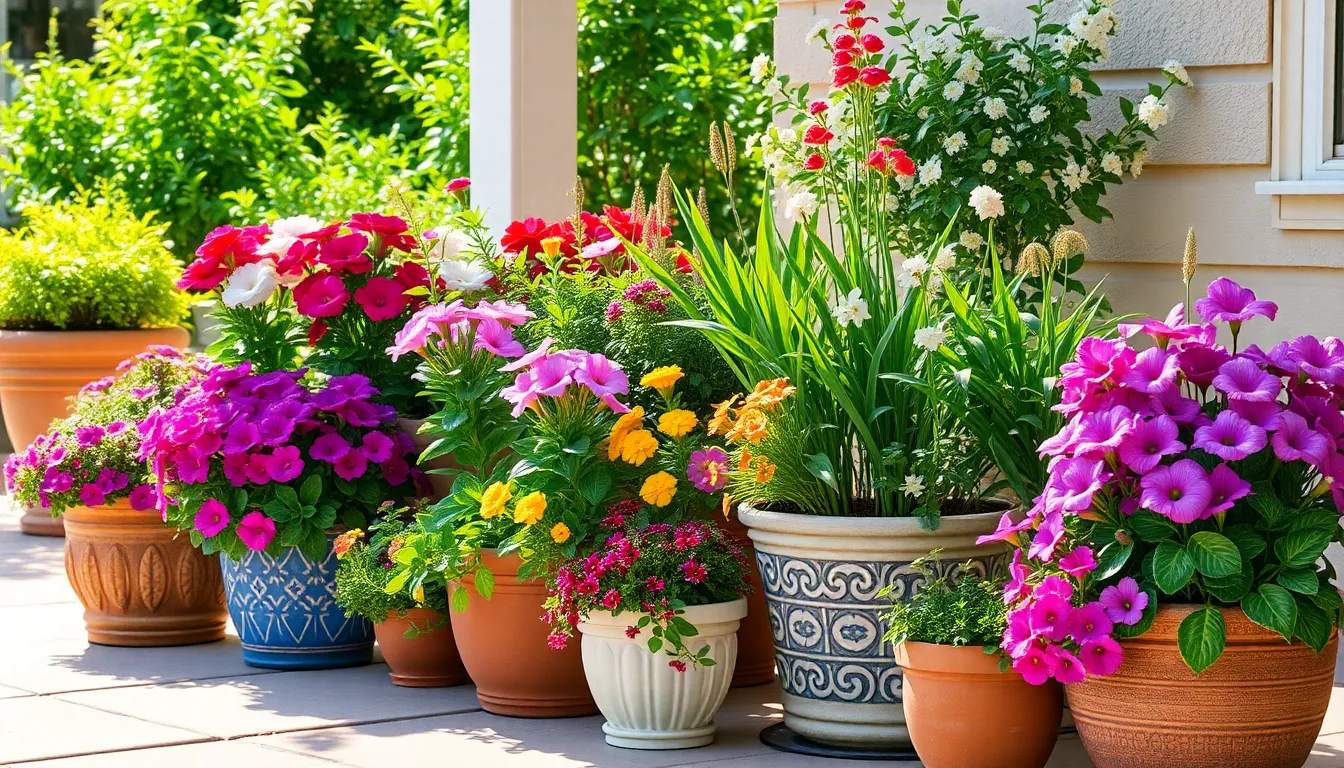
Success with part sun container plants depends heavily on creating the right growing environment. We’ll focus on two critical elements that make the difference between thriving plants and struggling ones.
Choosing the Right Potting Mix
Premium potting mixes designed specifically for containers provide the ideal foundation for part sun plants receiving 3 to 6 hours of daily sunlight. Standard garden soil becomes too heavy and compacted in containers, which restricts root growth and drainage.
Components like peat moss, coconut coir, perlite, and vermiculite create the perfect balance of moisture retention and aeration that part sun plants need. These materials work together to hold water while preventing the soggy conditions that lead to root rot.
Slow release granular fertilizer mixed into the potting medium at planting time ensures steady nutrition for several months. Container plants are heavy feeders since they can’t access nutrients from surrounding soil like ground planted varieties.
Organic matter additions improve both water retention and nutrient availability. We recommend supplementing with a balanced 10-10-10 NPK time release fertilizer to support healthy growth throughout the growing season.
Water soluble fertilizer applications at half strength every two to three weeks provide additional nutrition starting one month after planting. This feeding schedule matches the high nutrient demands of container grown plants during their active growing period.
Ensuring Proper Drainage Systems
Drainage holes in every container prevent water from pooling around roots and causing deadly root rot conditions. Without proper drainage, even the best potting mix becomes waterlogged and harmful to plant health.
Thorough watering until water runs from drainage holes ensures moisture reaches the entire root zone. This technique confirms that dry spots in the container receive adequate hydration while excess water escapes freely.
Soil surface dryness indicates watering time for most part sun container plants. We check by inserting a finger about an inch into the potting mix, especially during warmer weather when evaporation increases.
Aerating components like perlite maintain oxygen circulation around roots while improving drainage performance. These lightweight materials prevent soil compaction and create the well draining environment that container plants require.
Morning watering schedules reduce prolonged leaf wetness that encourages fungal diseases. Avoiding late day watering gives plants time to dry before cooler evening temperatures arrive.
Watering Strategies for Part Sun Container Plants Success
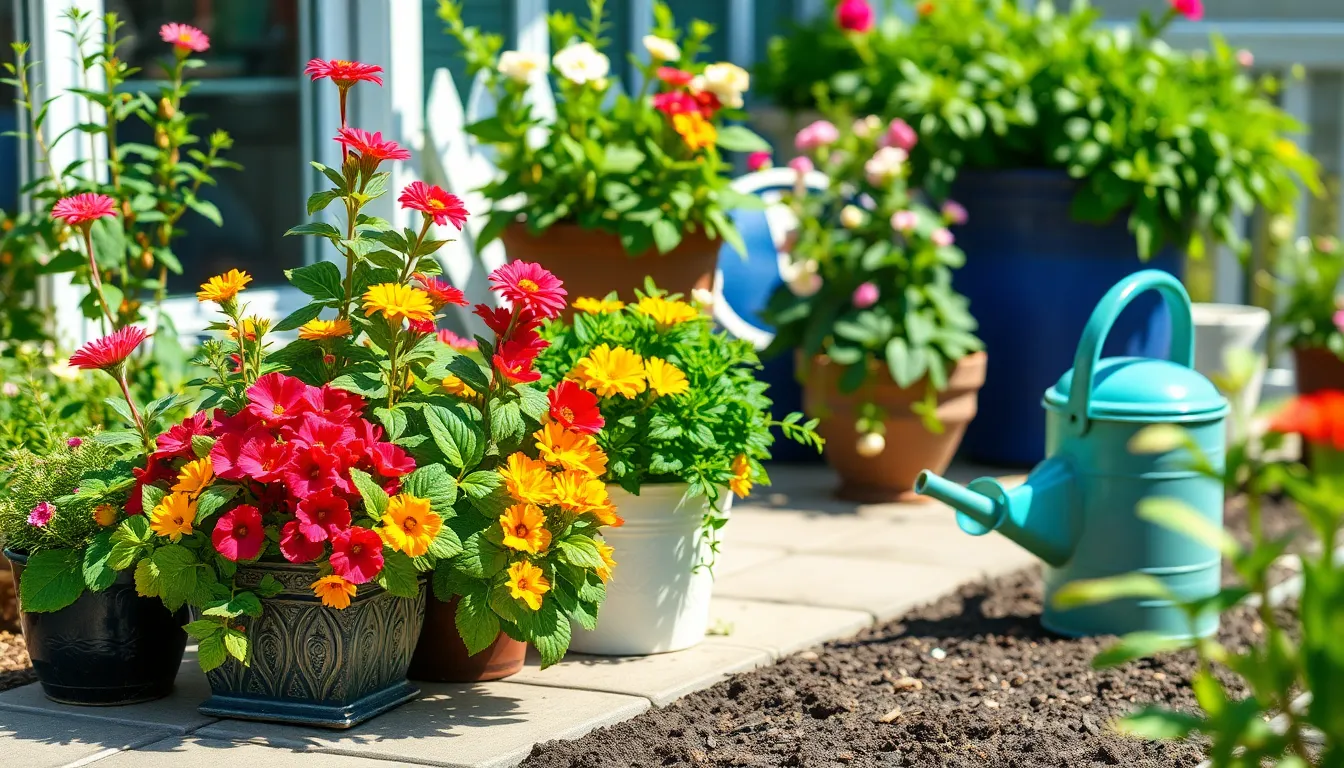
Proper watering techniques make the difference between thriving part sun container plants and struggling ones. We’ll explore proven methods that ensure your plants receive optimal hydration while preventing common watering mistakes.
Morning Watering Techniques
Direct water near the root zone rather than spraying over foliage to minimize leaf wetness and potential disease development. Morning watering allows plants to absorb moisture before the day’s heat intensifies while giving leaves ample time to dry completely.
Apply water thoroughly until it drains from the container’s bottom holes, ensuring deep root penetration and encouraging healthy root development. We recommend using a watering can with a rose attachment or a gentle hose setting to control water flow and prevent soil displacement.
Avoid watering late in the day since prolonged leaf wetness throughout the night creates ideal conditions for fungal diseases to develop. Early morning watering between 6-10 AM provides plants with the moisture they need while allowing sufficient drying time before evening temperatures drop.
Monitoring Moisture Levels
Check the top layer of soil daily by inserting your finger about one inch deep into the potting mix. Container plants dry out faster than garden beds due to their limited soil volume and increased exposure to air circulation.
Water when the soil surface feels dry to the touch but before plants show signs of stress like wilting or drooping leaves. This moisture monitoring technique prevents both overwatering and underwatering while encouraging deeper root growth.
Establish a consistent watering schedule during the first two weeks after planting by watering every other day to help new plantings develop strong root systems. Once established, water frequency will depend on weather conditions, with daily watering often necessary during hot summer months.
Prevent root rot by ensuring containers never sit in standing water, which suffocates roots and creates anaerobic soil conditions. Use saucers only when necessary and empty them within 30 minutes of watering to maintain proper drainage.
Seasonal Care Tips for Part Sun Container Plants
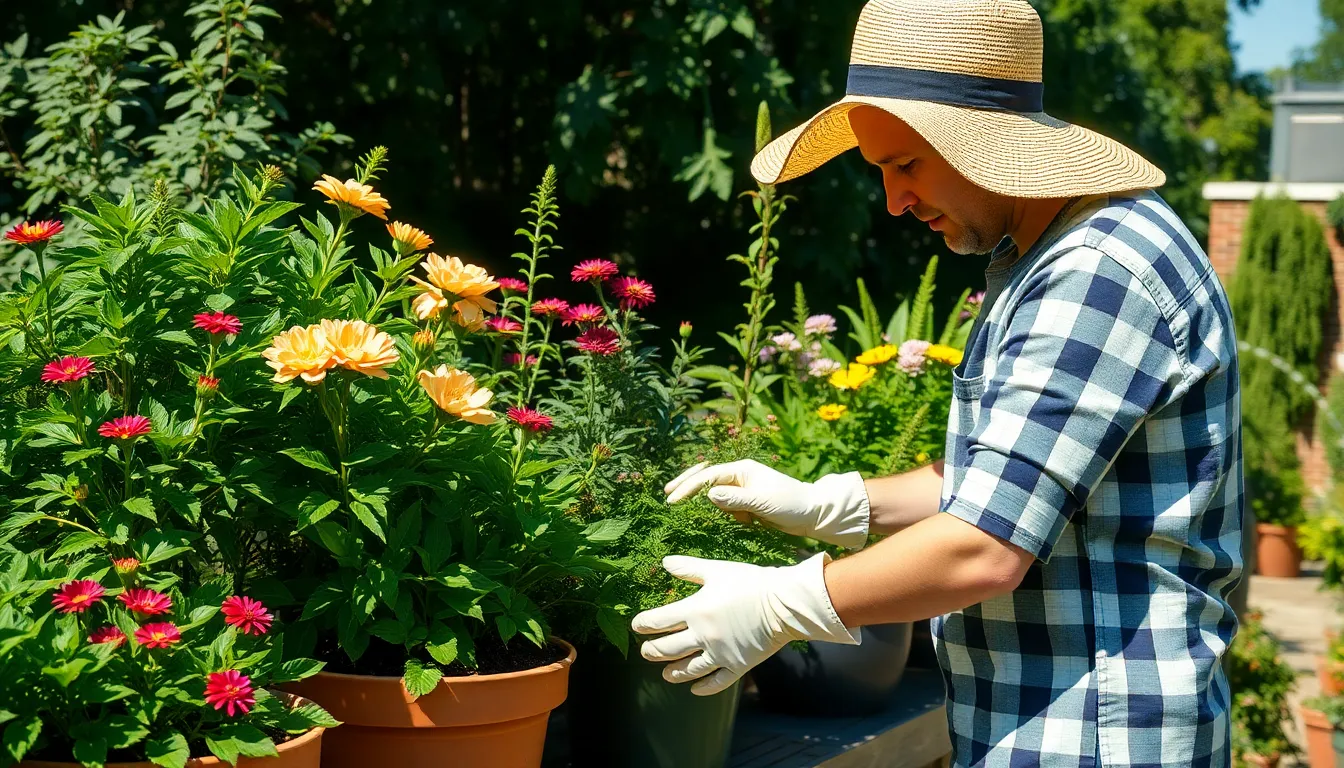
Successfully growing part sun container plants requires adapting our care routines to match each season’s unique demands. We’ll ensure year-round success by following these essential seasonal guidelines.
Spring Planting and Setup
Timing your container setup begins with identifying areas that receive 3 to 6 hours of sunlight with natural shade periods throughout the day. We recommend selecting plants at varying heights to create visual interest while ensuring they all thrive in part sun conditions.
Preparing the growing medium requires high-quality potting soil mixed with time-release fertilizer to provide essential nutrients from the start. Fresh potting mix should be replenished annually to maintain soil quality and nutrient levels for optimal plant health.
Watering newly planted containers involves thorough initial watering to settle soil around roots, followed by every-other-day watering for the first two weeks. We adjust this schedule based on weather conditions while monitoring soil moisture levels closely.
Fertilizing at planting time means incorporating balanced granular fertilizer (synthetic or organic) that feeds plants gradually over several months. This initial feeding establishes a strong foundation for healthy growth throughout the growing season.
Summer Maintenance and Protection
Daily watering becomes essential when soil surfaces feel dry, which often occurs during hot weather periods. We water deeply until drainage appears at container bottoms, ensuring roots receive adequate hydration while avoiding late-day watering that promotes leaf diseases.
Supplemental feeding supports active growth through half-strength water-soluble fertilizer applications every 2-3 weeks during peak growing periods. This regular nutrition boost maintains plant vigor when natural soil nutrients become depleted.
Heat protection strategies include providing afternoon shade when possible to prevent stress on part sun plants during extreme temperatures. Moving containers to slightly shadier locations during heat waves helps maintain plant health.
Regular maintenance tasks involve trimming overgrown sections to encourage bushier growth patterns and monitoring for common warm-season pests or diseases. We address problems promptly to prevent spread throughout our container gardens.
Fall Preparation and Winter Care
Reducing watering frequency becomes necessary as temperatures cool and plant growth naturally slows down. We gradually decrease watering schedules while continuing to monitor soil moisture levels for seasonal adjustments.
Pruning before winter removes dead or frost-damaged foliage to prevent decay and disease development during dormant periods. This cleanup reduces overwintering pest populations and maintains container garden health.
Winter protection methods depend on plant hardiness zones but often include moving containers to sheltered locations with reduced wind exposure. We insulate pots when necessary to protect root systems from freezing temperatures.
End-of-season cleanup involves removing spent plants and debris from containers to minimize pest and disease issues for the following year. This preparation sets the stage for successful spring planting and continued container garden success.
Common Mistakes to Avoid with Part Sun Container Plants
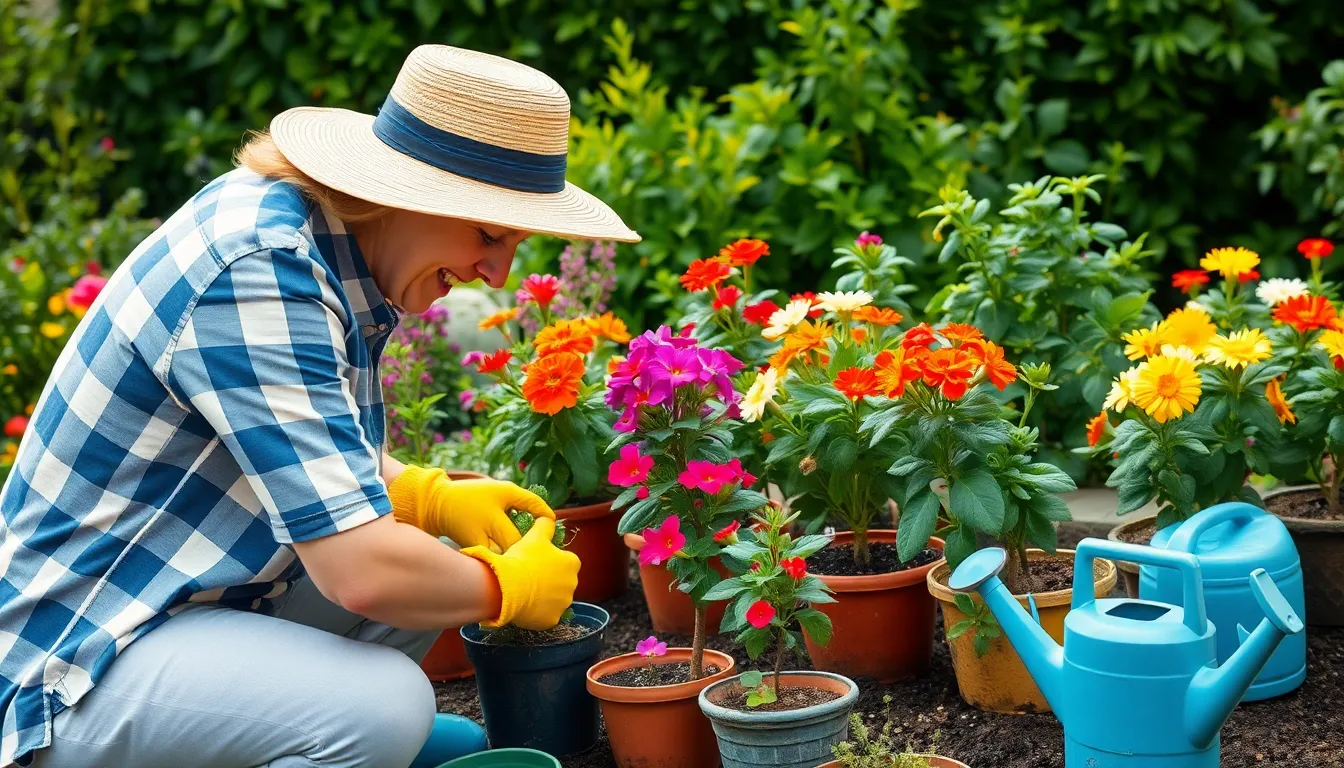
Even experienced gardeners can make critical errors when growing part sun container plants that receive 3 to 6 hours of sunlight daily. Learning from these common pitfalls helps ensure your containers thrive throughout the growing season.
Overwatering and Root Rot Prevention
Overwatering stands as the most frequent mistake we see in part sun container gardening, often leading to devastating root rot that kills plants. Container plants in partial sun conditions don’t dry out as quickly as those in full sun, making it easy to water too frequently.
Water your containers thoroughly only when the soil surface feels dry to the touch rather than following a rigid schedule. Deep watering until water drains from the bottom ensures proper root moisture while preventing surface level dampness that encourages fungal growth. Avoid watering late in the day since wet foliage overnight significantly increases disease risk in the humid conditions that part sun areas often experience.
Choose potting mixes with excellent drainage properties and avoid heavy or compacted soils that retain excess moisture. Containers dry out faster than ground soil, but poor drainage creates the perfect environment for root damage that we want to prevent at all costs.
Container Size and Plant Spacing Issues
Selecting containers that are too small or crowding multiple plants together creates unnecessary stress and competition among your part sun plants. Containers must be large enough to accommodate root systems without restricting growth, especially since part sun plants often develop extensive root networks to maximize nutrient uptake.
Overcrowded plants compete fiercely for water, nutrients, and the limited light available in part sun conditions, causing weakness and poor performance. Allow sufficient spacing between plants to promote air circulation, which reduces disease risk and supports healthy growth in these more humid environments.
Use containers with adequate drainage holes to prevent waterlogging while facilitating healthy root development. Proper spacing becomes even more critical in part sun areas where air movement may be limited compared to full sun locations, making good plant placement essential for preventing fungal issues.
Conclusion
Creating stunning part sun container gardens opens up endless possibilities for every gardener. We’ve shown you how to transform any space into a thriving oasis with the right plant selections proper care techniques and seasonal adjustments.
Whether you’re growing colorful flowers productive herbs fresh vegetables or low-maintenance succulents success lies in understanding your plants’ exact needs. Remember that proper soil drainage consistent watering and appropriate container sizing make all the difference.
Start small experiment with different combinations and don’t be afraid to make adjustments as you learn. Your part sun container garden will reward you with beauty productivity and the satisfaction of nurturing plants in any lighting condition.
Frequently Asked Questions
What are part sun plants and how much sunlight do they need?
Part sun plants are varieties that thrive in areas receiving 3-6 hours of direct sunlight daily. These versatile plants are perfect for partially shaded spaces like patios, balconies, or areas with morning sun and afternoon shade. They offer an ideal solution for gardeners who don’t have access to full-sun locations but still want beautiful blooms, lush foliage, and productive harvests.
Which flowering plants work best in part sun container gardens?
The best flowering plants for part sun containers include begonias (both wax and tuberous varieties), impatiens, and coleus. Wax begonias provide continuous summer blooms with minimal maintenance, while tuberous begonias offer dramatic large flowers. Impatiens excel in shadier spots with vibrant colors, and coleus provides stunning foliage that often outshines traditional flowers in part sun conditions.
Can I grow herbs in part sun containers?
Yes, many herbs thrive in part sun containers. Basil adapts well to partial sunlight with proper care, especially varieties like Genovese and Nufar. Parsley is particularly reliable in shadier conditions and perfect for year-round harvesting. Chives are an excellent low-maintenance perennial option that thrives in part sun and encourages healthy growth through regular cutting and harvesting.
What vegetables grow well in part sun container gardens?
Leafy greens are ideal for part sun containers, including lettuce, spinach, Swiss chard, arugula, and kale. These crops thrive in limited sunlight while providing fresh produce. Lettuce works well as a “cut-and-come-again” crop. Cherry tomatoes and smaller pepper varieties also perform well in part sun conditions, though they require well-draining soil and regular feeding for optimal growth.
Which perennial plants are best for long-term part sun containers?
Hostas are excellent for reliable foliage appeal with low maintenance requirements. Astilbe provides feathery flower plumes that add vertical drama and texture, thriving in moisture-rich conditions. Coral bells offer colorful leaves and delicate blooms, making them perfect fillers in mixed containers. These perennials provide lasting value and seasonal interest for container gardens.
Are succulents suitable for part sun container gardening?
Yes, several succulents work well in part sun containers. Jade plants offer indoor-outdoor flexibility with minimal watering needs, perfect for busy gardeners. Echeveria varieties provide striking rosette formations and thrive in bright, indirect sunlight. Sedum species are resilient with creeping growth habits, making excellent ground cover options that add texture and seasonal color to containers.
What type of soil should I use for part sun container plants?
Use premium potting mixes specifically designed for containers, which provide the right balance of moisture retention and aeration. Incorporate slow-release granular fertilizers and organic matter to support healthy growth. Avoid garden soil, which can become compacted in containers. The potting mix should drain well while retaining enough moisture for plant roots.
How often should I water part sun container plants?
Water when the soil surface feels dry, typically checking daily during hot weather. Use morning watering techniques, directing water near the root zone to minimize leaf wetness and prevent disease. Establish a consistent watering schedule, especially during the first few weeks after planting. Avoid overwatering and ensure containers have proper drainage to prevent root rot.
What seasonal care do part sun container plants need?
Spring involves planting setup with quality potting soil and time-release fertilizer. Summer requires daily watering, supplemental feeding, and heat protection. Fall calls for reduced watering frequency and pruning preparation. Winter may involve moving containers to sheltered locations and insulating pots. End-of-season cleanup helps minimize pest and disease issues for the following year.
What common mistakes should I avoid with part sun container plants?
Avoid overwatering, which leads to root rot – only water when soil feels dry and use well-draining potting mixes. Don’t choose containers that are too small, as this restricts root growth. Ensure adequate plant spacing for proper air circulation and healthy growth. Avoid using garden soil instead of quality potting mix, and don’t forget to provide proper drainage holes in containers.

